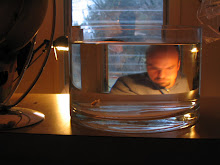Thursday, July 5, 2012
Coming together
You watched, perhaps, the local fireworks; thousands of miles away, I slept. You complained of the brutal heat, maybe, while on the beach of Camps Bay, Cleo and I felt the cool of the sand through our clothes as we fashioned a pretend cake. You went to bed, and I rose, and followed her to the living room, fired up a new episode of Wonder Pets, and made a cup of tea.
But now, thanks to the magic of text and what Judy Densch's character in The Best Exotic Marigold Hotel calls the Interweb, we're on the same page. I type; the keystrokes create electrical impulses that are stored in a tiny reconfiguration of microchip circuitry; I upload, and bundles of data are sent to and through servers, from which they can then be accessed (in a series of steps that still boggles my analog mind) by your own computer's hard drive.
"Semiotics," I read in Anne D'Alleva's Methods & Theories of Art, on the second floor of UCT's main library, "is the theory of signs. Simply put, a sign is something that represents something else. Here's an example: look out of the window and find a tree. There are all sorts of signs for that thing you're looking at."
This morning, during a bright, cold daybreak, I carried Cleo down our local hill to Melissa's, a gourmet grocery and cafe, so that a sick L. could have a little time to herself. I ordered a flat white, to which Cleo judiciously added some brown sugar, and we waited on the first round of muffins: a few minutes later, a steaming bran and nut muffin appeared on our table. We added a small pat of butter; it melted on contact, and ran down the crusty sides. Waiting for the muffin to cool, we picked up a magazine: a copy of National Geographic: Kids. In the center of the magazine was a photo essay about what the editors called the new seven wonders of the natural world - and the first was Cape Town's own Table Mountain.
"Look!" I said to Cleo, and pointed to the glossy photo of the remarkable peak. "Table Mountain!" "And look" - and I gestured outside, beyond the large cafe windows, toward the mountain that stood above us. "It's the same." Sign and object, signifier and referent, related directly. A nifty semiotic match, with as little slippage as possible. A lovely moment.
But how lovely, exactly? Along comes the irreverent Oscar Wilde, in the day's second reading, to pressure my sensation. In his playful, provocative "The Critic as Artist," Wilde argues at one point that music is in fact the perfect type of art precisely because it cannot represent its object realistically at all. The thoughtful critic will turn, he says, away from merely illustrative paintings and literal casts, and will reject modes of art that have but one message to deliver. Put down, in short, that photo of Table Mountain, and pursue a reverie instead; craft an ode; enjoy a symphony to the slopes.
Ah. Understood. But the photo was in fact never the source of my small joy - which was rooted, instead, in fortuitous correspondence, and in a surprise at the collapse of there (the editor's decision) and here (the peak above us). A pleasure now perpetuated, I hope, in your reading this text, composed in Cape Town at 11:07 a.m. local time.
Subscribe to:
Post Comments (Atom)





No comments:
Post a Comment